
|
Astronomy Picture Of the Day (APOD)
 Jupiter Over the Mediterranean
Jupiter Over the Mediterranean
7.09.2009
This vacation included a sight to remember. Pictured above, a picturesque starscape capped a serene seascape as seen from Turkey this past August. In the above digitally stitched panorama, the Gelidonya Lighthouse shines in the foreground before a calm Mediterranean Sea.
 CMBR Dipole: Speeding Through the Universe
CMBR Dipole: Speeding Through the Universe
6.09.2009
Our Earth is not at rest. The Earth moves around the Sun. The Sun orbits the center of the Milky Way Galaxy. The Milky Way Galaxy orbits in the Local Group of Galaxies. The Local Group falls toward the Virgo Cluster of Galaxies.
 Supernova Remnant E0102 72
Supernova Remnant E0102 72
5.09.2009
The expanding debris cloud from the explosion of a massive star is captured in this multiwavelength composite, combining x-ray and optical images from the Chandra and Hubble telescopes. Identified as E0102-72, the supernova remnant lies about 190,000 light-years away in our neighboring galaxy, the Small Magellanic Cloud.
 6 Years of Saturn
6 Years of Saturn
4.09.2009
Today, planet Earth passes through the plane of Saturn's rings. From the perspective of earthbound astronomers, Saturn's rings will be edge-on. The problem is, Saturn itself is now very close to the Sun, low on horizon after sunset, so good telescopic images will be difficult to come by.
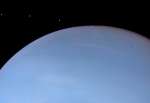 Despina, Moon of Neptune
Despina, Moon of Neptune
3.09.2009
Despina is a tiny moon of Neptune. A mere 148 kilometers across, diminutive Despina was discovered in 1989, in images from the Voyager 2 spacecraft taken during its encounter with the solar system's most distant gas giant planet.
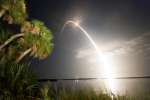 Discovery s Rainbow
Discovery s Rainbow
2.09.2009
Just one minute before midnight EDT, Friday, August 28, the Space Shuttle Discovery began a long arc into a cloudy sky. Following the launch, a bright and remarkably colorful trail was captured in this time exposure from the Banana River Viewing Site, looking east toward pad 39A at the Kennedy Space Center.
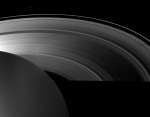 Shadows of Saturn at Equinox
Shadows of Saturn at Equinox
1.09.2009
Unusual shadows and dark rings appeared around Saturn near its equinox last month. At that time -- early August -- Saturn's ring plane pointed directly at the Sun. Visible above, Saturn's moon Tethys casts a shadow visible only on the far right.
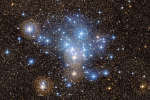 Open Cluster M25
Open Cluster M25
31.08.2009
Many stars like our Sun were formed in open clusters. The above pictured open cluster, M25, contains thousands of stars and is about two thousand light years distant. The stars in this cluster all formed together about 90 million years ago. The bright young stars in M25 appear blue.
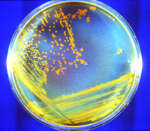 D. rad Bacteria: Candidate Astronauts
D. rad Bacteria: Candidate Astronauts
30.08.2009
These bacteria could survive on another planet. In an Earth lab, Deinococcus radiodurans (D. rad) survive extreme levels of radiation, extreme temperatures, dehydration, and exposure to genotoxic chemicals. Amazingly, they even have the ability to repair their own DNA, usually with 48 hours. Known as an extremophile, bacteria such as D.
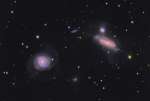 NGC 7771 Galaxy Group
NGC 7771 Galaxy Group
29.08.2009
Slide your cursor over the image to identify three members of this intriguing gathering of galaxies. Known as the NGC 7771 Group, they lie almost 200 million light-years away toward the high flying constellation Pegasus.
|
January February March April May June July August September October November December |
|||||||||||||||||||||||||||||||||||||||||||||||||